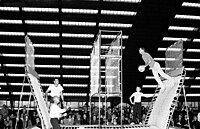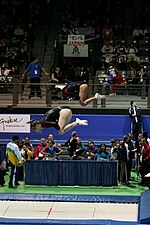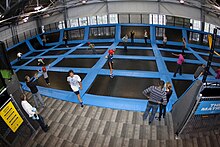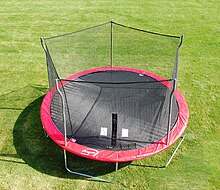Play It Again Sports Mini Trampoline

A youth bouncing on a trampoline
A trampoline is a device consisting of a piece of taut, strong fabric stretched between a steel frame using many coiled springs. Not all trampolines have springs, as the Springfree Trampoline uses drinking glass-reinforced plastic rods. People bounce on trampolines for recreational and competitive purposes.
The fabric that users bounciness on (commonly known as the "bounce mat" or "trampoline bed") is not elastic itself; the elasticity is provided by the springs that connect it to the frame, which store potential energy.
History [edit]
Early trampoline-like devices [edit]


Iñupiat blanket toss during the Nalukataq festival in Barrow, Alaska (2006)
A game similar to trampolining was developed by the Inuit, who would toss coating dancers into the air on a walrus pare ane at a time (see Nalukataq) during a jump celebration of whale harvest. There is also some evidence of people in Europe having been tossed into the air by a number of people holding a blanket. Mak in the Wakefield Mystery Play The Second Shepherds' Play, and Sancho Panza in Don Quixote, are both subjected to blanketing – still, these are clearly not-voluntary, non-recreational instances of quasi-judicial, mob-administered punishment. The trampoline-similar life nets in one case used by firefighters to catch people jumping out of burning buildings were invented in 1887.
The 19th-century poster for Pablo Fanque'south Circus Royal refers to performance on trampoline. The device is thought to take been more than like a springboard than the fabric-and-coiled-springs appliance before long in use.[ane]
These may not be the true antecedents of the mod sport of trampolining, simply betoken that the concept of bouncing off a fabric surface has been around for some time. In the early on years of the 20th century, some acrobats used a "bouncing bed" on the stage to charm audiences. The bouncing bed was a form of small trampoline covered by bedclothes, on which acrobats performed mostly comedy routines.
According to circus folklore, the trampoline was supposedly first developed by an artiste named du Trampolin, who saw the possibility of using the trapeze safe net every bit a course of propulsion and landing device and experimented with different systems of suspension, eventually reducing the net to a practical size for separate performance. While trampoline-similar devices were used for shows and in the circus, the story of du Trampolin is almost certainly apocryphal. No documentary evidence has been found to support information technology.
William Daly Paley of Thomas A. Edison, Inc. filmed blanket tossing initiation of a new recruit in Company F, 1st Ohio Volunteers in 1898.[2]
First modern trampolines [edit]
The first modern trampoline was congenital by George Nissen and Larry Griswold in 1936.[3] Nissen was a gymnastics and diving competitor and Griswold was a tumbler on the gymnastics team, both at the University of Iowa, United States. They had observed trapeze artists using a tight net to add together entertainment value to their performance and experimented past stretching a piece of canvas, in which they had inserted grommets forth each side, to an angle iron frame by means of coiled springs. It was initially used to railroad train tumblers but presently became popular in its own right. Nissen explained that the name came from the Spanish trampolín, meaning a diving board. Nissen had heard the word on a demonstration tour in Mexico in the late 1930s and decided to use an anglicized form equally the trademark for the apparatus.[4]
In 1942, Griswold and Nissen created the Griswold-Nissen Trampoline & Tumbling Visitor, and began making trampolines commercially in Cedar Rapids, Iowa.
The generic term for the trademarked trampoline was a rebound tumbler [5] and the sport began equally rebound tumbling. It has since lost its trademark and has become a generic trademark.[ citation needed ]

1968 demonstration of Spaceball
Early on in their development Nissen anticipated trampolines being used in a number of recreational areas, including those involving more than i participant on the same trampoline. Ane such game was Spaceball—a game of two teams of two on a single trampoline with specially synthetic end "walls" and a middle "wall" through which a ball could exist propelled to hit a target on the other side's terminate wall.[six]
Utilize in flight and astronaut grooming [edit]
During World War Two, the United States Navy Flying Schoolhouse developed the employ of the trampoline in its training of pilots and navigators, giving them concentrated practice in spatial orientation that had non been possible before.[7] After the state of war, the development of the space flight program once more brought the trampoline into employ to help train both American and Soviet astronauts, giving them experience of variable body positions in flying.
Competitive sports [edit]

Girls competing in synchronised trampoline
The beginning Trampoline Earth Championships were organised by Ted Blake of Nissen, and held in London in 1964. The showtime World Champions were both American, Dan Millman and Judy Wills Cline. Cline went on to dominate and become the almost highly busy trampoline champion of all time.
Ane of the earliest pioneers of trampoline as a competitive sport was Jeff Hennessy, a coach at the Academy of Louisiana at Lafayette. Hennessy likewise coached the United States trampoline squad, producing more than world champions than any other person. Among his world champions was his girl, Leigh Hennessy. Both Jeff and Leigh Hennessy are in the USA Gymnastics Hall of Fame.
The competitive gymnastic sport of trampolining has been part of the Olympic Games since 2000. On a modernistic competitive trampoline, a skilled athlete can bounce to a height of upwardly to 10 metres (33 ft), performing multiple somersaults and twists. Trampolines too feature in the competitive sport of Slamball, a variant of basketball game, and Bossaball, a variant of volleyball.
Cantankerous-preparation for other sports [edit]
There are a number of other sports that apply trampolines to help develop and hone acrobatic skills in training before they are used in the actual sporting venue. Examples can exist found in diving, gymnastics, and freestyle skiing. One master advantage of trampolining as a grooming tool for other acrobatic sports is that it allows repetitive drill practice for acrobatic experience every ii seconds or less, compared with many minutes with sports that involve hills, ramps or loftier platforms. In some situations, it can likewise exist safer compared to landings on the basis.
Types of trampolines [edit]
The frame of a competitive trampoline is fabricated of steel and can be made to fold upwards for transportation to competition venues. The trampoline bed is rectangular 4.28 by 2.14 metres (14 ft 1 in × 7 ft 0 in) in size fitted into the 5.05 by 2.91 metres (17 ft × x ft) frame[viii] with around 110 steel springs (the actual number may vary by manufacturer). The bed is made of a stiff textile, although this is not itself elastic; the elasticity is provided only past the springs. The textile can be woven from webbing, which is the well-nigh commonly used material. Still, in the 2007 World Championships held in Quebec City, a Ross bed (or two-string bed), woven from individual thin strings, was used. This type of bed gives a lilliputian actress tiptop to the rebound.

Recreational trampolines for dwelling use are less sturdily synthetic than competitive ones and their springs are weaker. They may exist of various shapes, though most are circular, octagonal or rectangular. The textile is usually a waterproof canvass or woven polypropylene material. As with competitive trampolines, recreational trampolines are commonly made using coiled steel springs to provide the rebounding force, but spring-free trampolines also exist.
Commercial trampoline parks [edit]

House of Air Trampoline Park in San Francisco
In 1959 and 1960, it became very popular to have outdoor commercial "jump centres" or "trampoline parks" in many places in Northward America where people could savour recreational trampolining. Still, these tended to accept a high accident charge per unit, and the public's interest rapidly waned.[9]
In the early on 21st century, indoor commercial trampoline parks have made a comeback, with a number of franchises operating across the The states and Canada. ABC News has reported that in 2022 there were at least 345 trampoline parks operating in the United States.[10] Similar parks have more recently been opened in other countries.[xi] The International Association of Trampoline Parks (IATP) estimated that park numbers had grown from 35-40 parks in 2011 to around 280 in 2014. The post-obit year, IATP estimated that 345 parks were open by the end of 2014, and that some other 115 would open by the stop of 2022 in North America. IATP also estimated that at the end of 2022 there were forty parks outside of North America, and that by the terminate of 2022 there would be at least 100 indoor trampoline parks open internationally.[12] [13] As of March 2019, CircusTrix (and its subsidiary Sky Zone) is the largest operator of trampoline parks in the U.S. and in the world,[14] [xv] with 319 parks operating nether their brands.[sixteen] [17]
These commercial parks are located indoors, and take wall-to wall-trampolines to forbid people falling off the trampolines on to hard surfaces. Padded or leap walls protect people from impact injuries. Despite these precautions, at that place has been at least i death recorded due to a head-first landing at a trampoline park.[18] In March 2012, New York Yankees pitcher Joba Chamberlain seriously injured his ankle while jumping at a commercial jump centre in Tampa with his son.[19] In 2018, a human died in a British Columbia trampoline park, which prompted calls for more safety regulations for these pop activities.[20]
Wall running [edit]

Wall running is a sport where the participant uses a wall and platforms placed next to the trampoline bed to do tricks. The basic motility is a backdrop on the trampoline and and then the anxiety touching the wall at the top of the bounce. From there, there is no limit to the acrobatic movements that are possible, similar to regular trampolining. The advantage is that twists and turns tin can be initiated more forcefully from a solid wall and that the vertical speed tin be transferred to rotation in addition to forces from the legs or arms. Additionally, energy can exist gained both from the bed at the bottom of the bounce, and from the wall at the superlative of the bounciness.
Condom [edit]

With safety nets, the run a risk of falling off the trampoline is reduced.
Using a trampoline can be dangerous. Organized clubs and gyms usually have large rubber end-decks with foam pads at each end, and spotters are placed alongside the trampoline to endeavour to break the autumn of any athlete who loses control and falls. In 1999, the U.S. Consumer Product Safety Commission estimated there were 100,000 infirmary emergency room visits for trampoline injuries.[21]
Due to the much larger numbers involved and bottom safety standards, the bulk of injuries occur on privately owned home trampolines or in commercial trampoline facilities rather than organized gyms.[22]
CBC Tv's Marketplace discovered that the trampoline park industry is unregulated in Canada, with different standards for padding and foam pit depth, self-inspections and repairs, and not being required to report injuries. It was also noted that there were generally as well few staff to enforce rules, and that promotional advertisements often showed participants engaging in somersaults even though this was extremely dangerous without proper grooming. All trampoline parks rely upon liability waivers, where the signee assumes the run a risk of the activity including when injuries result from the institution's own negligence or poorly maintained equipment, rather than lamentatory up safe standards and supervision.[23] [24]
Bouncing off a trampoline tin issue in a fall of 3–4 metres (10–thirteen ft) from the peak of a bounce to the basis or a fall into the suspension springs and frame. There has been an increase in the number of home trampolines in contempo years and a corresponding increment in the number of injuries reported. Some medical organizations take suggested that the devices exist banned from home use.[25] [26]
Authorities recommend that simply one person should be allowed to jump at a fourth dimension to avoid collisions and people being catapulted in an unexpected direction or college than they expect. One of the most common sources of injury is when multiple users are bouncing on the trampoline at one fourth dimension. More ofttimes than non, this situation leads to users billowy into one some other and thus condign injured; many suffer broken basic as a event of landing desperately afterward knocking into another user.[26]

A recreational trampoline with a safety net enclosure
Another of the about common sources of serious injury is an attempt to perform somersaults without proper training. In some cases, people land on their neck or caput, which can crusade paralysis or fifty-fifty expiry.[26] In an infamous incident in the 1960s, pole-vaulting champion Brian Sternberg became paralyzed from the neck downwards in a trampoline blow.
Danger tin can be reduced by burying the trampoline and so the bed is closer to the surrounding surface to lessen falling distance, and padding that surrounding area. Pads over the spring and frame reduce the severity of affect injuries. Keeping the springs covered also reduces the take a chance of a limb falling between the gaps in the springs and the rest of the body falling off the trampoline.
Kits are available for abode trampolines that provide a retaining net around the trampoline and forestall users from bouncing over the edge. The American Academy of Pediatrics states that in that location is no epidemiological evidence that these ameliorate safety.[26] The nets do prevent jumpers falling off the trampoline onto the footing, but these falls are not the most common source of injury. Multiple users bouncing in a netted trampoline can nonetheless be injured. Safety internet enclosures have a larger benefit for safeguarding solo trampolinists, so long as they avoid falling on their head or neck.
Having some preparation in a gym may be beneficial in alerting people to possible hazards and provide techniques to avoid bad falls.[27]
Family-oriented commercial areas in North America, such as shopping centres, carnivals, and so on, often include closed inflatable trampolines (CITs) as a children's attraction. These have safety nets on the sides to prevent injuries.
Mini-trampolines [edit]

A mini-trampoline (besides known every bit a rebounder, trampette, jogging trampoline, or exercise trampoline) is a type of trampoline less than 1 metre (3 ft 3 in) in diameter and virtually 30 centimetres (12 in) off the ground, often kept indoors and used as part of a physical fitness regime. So-chosen rebounding provides a form of exercise with a low bear on on knees and joints. Mini-trampolines do not give a rebound as loftier as larger recreational or competitive trampolines. Most section and large-box stores sell mini-trampolines.
Educational utilize [edit]
Trampoline activity has been used by science teachers to illustrate Newton'south Iii Laws of Motion, too as the "rubberband collision."[28]
In co-operation with the Academy of Bremen and the German Aerospace Center (DLR), the machtWissen.de Corporation from Bremen, Germany developed the weightlessness demonstrator "Gravity Jumper" based on a trampoline. Due to the dispatch during the bound, an acceleration forcefulness takes effect in addition to the usual gravitational force. Both forces add up and the person on the trampoline seems to become heavier. As before long as the jumper leaves the trampoline, he is under a gratuitous fall condition, which means that the jumper seems weightless and does not experience the acceleration due to gravity. Every person receives a iii-centrality acceleration sensor, fastened to them with a belt. The sensor transmits the information of the flight path to a monitor; a monitor shows the grade of the dispatch, including the weightless phase. The interplay of acceleration due to the trampoline and weightlessness becomes apparent.
References [edit]
- ^ "Sideshow World, Sideshow Performers from around the world". world wide web.sideshowworld.com. Archived from the original on March 3, 2016. Retrieved May three, 2018.
- ^ "Blanket-tossing a new recruit". Library of Congress, Washington, D.C. 20540 USA.
- ^ WestView Trampoline Customs site - Trampoline History p. 3
- ^ "Inventor of the Week Annal - George Nissen". Massachusetts Institute of Technology, MIT School of Applied science. March 2004. Archived from the original on June 30, 2007. Retrieved April 13, 2007.
- ^ Eskenazi, Gerald (May 3, 2018). A Sportswriter'due south Life: From the Desk of a New York Times Reporter. Academy of Missouri Press. ISBN9780826262608 . Retrieved May 3, 2018 – via Google Books.
- ^ "Trampoline history". Archived from the original on June 10, 2010.
- ^ "Trampoline Preparation During Globe War II". Trampoline History. WestView Trampoline Customs. Archived from the original on October vi, 2012.
- ^ "Apparatus Norms" (PDF). FÉDÉRATION INTERNATIONALE DE GYMNASTIQUE. Oct ane, 2019.
- ^ WestView Trampoline Community site - Trampoline History p. 19
- ^ "Big Bounce in Trampoline Parks Puts Safety in Spotlight". ABC News. June 30, 2015. Archived from the original on December 26, 2017. Retrieved May iii, 2018.
- ^ "Businessman turning former studios into a trampoline palace" Archived March iii, 2014, at the Wayback Car, Herald Tribune, March 20, 2013
- ^ Sarris, Tracy (April 1, 2014). "Indoor trampoline parks are 'springing' upwards everywhere!" (PDF). Association of Indoor Trampoline Parks. Archived from the original (PDF) on February 26, 2015. Retrieved March 28, 2017.
- ^ Sarris, Tracy (Apr 1, 2015). "Jump! Spin! Fly! Indoor trampoline parks proceed to be one of the fastest growing indoor entertainment attractions worldwide" (PDF). International Association of Trampoline Parks. Archived from the original (PDF) on March 29, 2017. Retrieved March 28, 2017.
- ^ Folio, Bubba (June 2, 2016). "Want to Snag Millennials on a Upkeep? Create Selfie-Worthy Experiences". Inc. Retrieved Baronial 27, 2016.
- ^ Park, Clayton (Oct xx, 2015). "Boxing between dueling trampoline parks shaping upwardly in Daytona". The Daytona Embankment News-Journal . Retrieved August 27, 2016.
- ^ "CircusTrix Pounces on Operator of Indoor Trampoline Parks". Wall Street Journal. February 1, 2018. Retrieved Feb nine, 2018.
- ^ Miracle, Veronica (August 25, 2016). "New Clovis location for Skywalk Extreme Sports Arena will house largest America Ninja Warrior course". KFSN-Tv set. Retrieved August 27, 2016.
- ^ "Maureen Kerley Pushes for Trampoline-Park Regulations Following 2012 Death of Son at Phoenix's SkyPark". Phoenix New Times. June five, 2013. Archived from the original on August 11, 2016. Retrieved June 15, 2016.
- ^ "Joba's a bullpen of calm on 911 record" Archived March 30, 2012, at the Wayback Machine, New York Daily News
- ^ "Decease at B.C. trampoline park prompts call for safety regulations". ctvnews.ca. January 26, 2018. Archived from the original on April half dozen, 2018. Retrieved May three, 2018.
- ^ "Trampolines" (PDF). U.Due south. Consumer Product Safe Commission. September 2000. Archived (PDF) from the original on January 26, 2017. Retrieved Feb 6, 2017.
- ^ "Doctors warn of trampoline injury risks" Archived August nine, 2016, at the Wayback Machine, CBC News - Health, September 24, 2012, retrieved August two, 2016
- ^ "Hidden camera reveals trampoline parks ignoring dangerous behaviour". CBC. Oct five, 2018. Retrieved July 6, 2019.
- ^ "The Truth Well-nigh Trampoline Parks". CBC. October 5, 2018. Retrieved July half dozen, 2019.
- ^ "Study Of Trampoline-Related Injuries Calls For Ban On Devices". sciencedaily.com. Archived from the original on September 24, 2015. Retrieved May 3, 2018.
- ^ a b c d Fitness, Council on Sports Medicine And (October 1, 2012). "Trampoline Safety in Babyhood and Boyhood". Pediatrics. 130 (4): 774–779. doi:10.1542/peds.2012-2082. PMID 23008455. Archived from the original on May 3, 2018. Retrieved May 3, 2018 – via pediatrics.aappublications.org.
- ^ Trampoline Safety Archived February eight, 2009, at the Wayback Machine, Consumer Affairs
- ^ Connolly, Sean (October 2016). The Book of Wildly Spectacular Sports Science. 225 Varick Street, New York, NY 10014-4381: Workman Publishing Co., Inc. p. 67. ISBN978-0-7611-8928-2.
{{cite book}}: CS1 maint: location (link)
External links [edit]
-
 Media related to Trampolines at Wikimedia Commons
Media related to Trampolines at Wikimedia Commons
Source: https://en.wikipedia.org/wiki/Trampoline
0 Response to "Play It Again Sports Mini Trampoline"
Postar um comentário